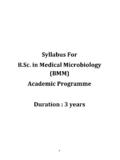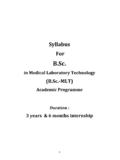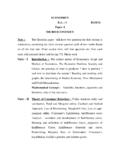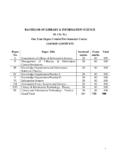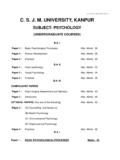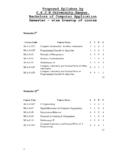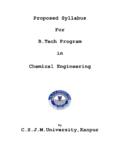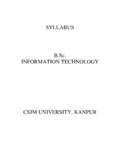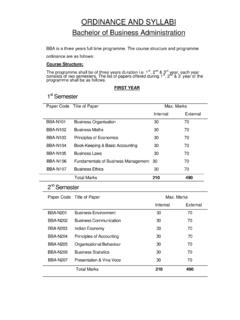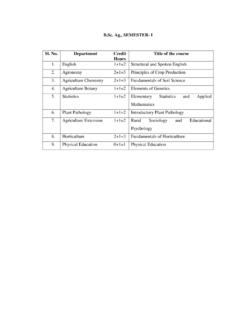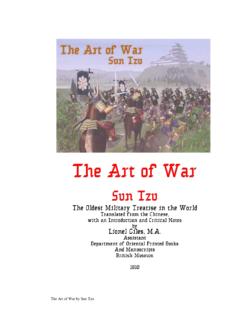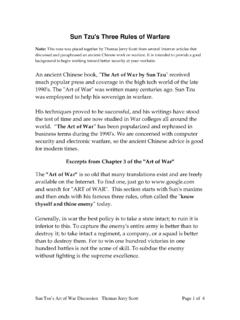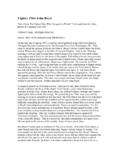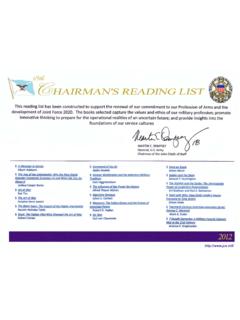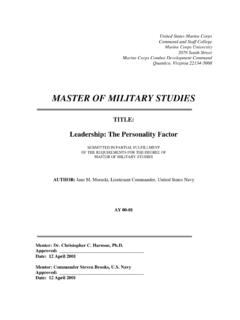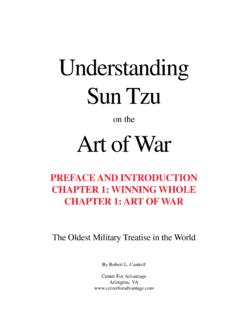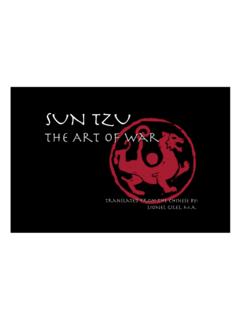Transcription of Format for U.G. Examination
1 Pg. 1 Format for Examination The entire curriculum is to be divided into four units and each question paper will have : 1. First question compulsory- Comprising of TEN Short Answer Questions (1 to X) covering the entire curriculum. This question will carry 40% marks of the total marks. 2. The rest of the question paper will be divided into Four Units, comprising of Two questions in each unit. Therefore , the total number of question in each paper shall be NINE. 3. Student will have to attempt one question from each unit. 4. All these (Four) questions will be of equal marks and will carry 60% marks of the total marks. 5. The minimum passing marks in each paper shall be 33% of the total marks. The candidate has to pass theory and practical separately. Total passing percentage (aggregate) to obtain the degree shall be 36%. 6. In the part I and II, there shall be two theory papers and one practical.
2 Maximum marks shall be 35/50 for and respectively. For practical, it shall be 30/50 marks for BA and respectively. pg. 2 7. In Part III there shall be three theory papers and one practical maximum marks shall be 35/50 for and respectively. For Practical, its shall be 45/75 marks for and respectively. SUMMARY OF PAPERS PART-I 1. art of war in India (upto 1947) 2. Evolution of Armament and Western Art of Warfare 3 Practical- Map Reading PART-II 1. art of war in India (after 1947) 2. National Security 3 Practical - TEWT PART-III 1. Evolution of Strategic Thought 2. Military Psychology 3. Study of War 4 Practical pg. 3 PART-I Paper-I art of war in India (upto 1947) : 35/50 Unit-I: Ancient India (a) Military system in Vedic and Epic Age. (b) Broad division of Armed forces. (c) Kautilya s Philosophy of War - organization and art of war Unit-II: Late Ancient Period: (a) Decline of chariots and rise of cavalry (b) Rajput Military system (c) Battle of Terrain 1192 Unit-III: Medieval India a) Invasion of Turks - Battle of Somnath b) Mughal Military systems - Mansabdari System, Battle of Khanwa.
3 C) Maratha Military System - Guerilla Concept, Third Battle of Panipat 1761 d) Sikh Military system - Battle of Soberaon (1846) Unit-IV: Modern India (a) Armed forces under East India Company (b) First war of Independence 1857 (c) Armed forces under the crown (d) Presidency Armies and Indianization of Armed Forces pg. 4 BOOKS RECOMMENDED 1. Singh S D - Ancient India war fare with special reference to vedic period. 2. Majumdar, - Military system in ancient India. 3. Majumdar, - Bhartiya sena ka itihas 4. Fular JFC - Generalship of Alexander the Great 5. Kongle, RP - Kautilaya's Arthashashtra 6. Sarkar Jadunath - Military history of India 7. Irvin - Bhartiya mugalon ki sainya vyavastha (translated) 8. Sen S N - Military system of maratha 9. Durf grant - Marathon ka itihas 10. Bajwa FS - Military system of sikh 11. Tripathi R P - Rise and fall of the mugal 12. Gupta N R - Marathas and Panipat 13. Sharma Y K - Military science part 1 14. Pandey and Chaubey - Sainya Adhyan 15.
4 Tewari, N P Bhartiya Sainya Itihaas (Sharda Prakashan Alld.) 16. Singh, Lallan ji - Bhartiya Sainya Itihaas aur Yudh Ke Siddhant pg. 5 PART-I Paper-II Evolution of Armament and Western Art of Warfare : 35/50 Unit-I: Age of Valour and Chivalry (a) Organization and art of war of Greek phalanx and Roman legion (b) Emergence of armour and armoured knights. Unit-II: Age of Gun powder and Steam (a) Tactical Reforms of Gustavas Adolphus (b) Development of naval power (c) Nation-in-arm Unit-III: Age of Oil and Atomic Energy (a) Technological innovations and their effect on war (b) Nations-at-war (c) New devices of world war-I and II (b) Effect of atom on war Unit-IV: Cyber warfare (a) Necessity of computer (b) Their use in war BOOKS RECOMMENDED 1. Fuller, Armament and History 2. Tandon, Pashchaty a Yodhan Sambhar. 3. Tewari, Yodhan Sambhar 4. Verma Yodhan Sambhar 5. Arther Birnie art of war 6. Abdul Kalam - Mere Sapno ka Bharat 7. Fuller The American Civil War 8.
5 Nuclear Weapon A book published by UNO 9. Martin Van Preveld Technology & War pg. 6 I- Practical Map Reading 1. Introduction of topographical sheet 2. Conventional signs - geographical and military 3. Finding out north by different methods 4. Grid system - Four figure and six figure map reference 5. Scale - simple and comparative scale, construction and interconversion 6. Liquid prismatic compass - uses by day and night 7. Bearing - interconversion and use of service protractor 8. Determination of position on a grided map, resection and intersection 9. Determination of visibility on survey maps of hilly region by gradient proportion and section drawing method. BOOKS RECOMMENDED- 1. Verma MP - Sainik manchitra vigyan 2. Sharma, YK - Map reading 3. Singh Balwant - An easy approach to map reading 4. Gale and Porden - A complete guide to military map reading 5. Srivastava, JM Practical military science part 1 6. Maliwal, BN - Military science pratical pg. 7 PART-II Paper-I art of war in India (after 1947) : 35/50 Unit-I: Partition of India (a) Status of Armed forces (b) Partition of India (c) genesis and prospects of Kashmir dispute (d) Military operation in Kashmir (1948) Unit-II: Sino-Indian war 1962 (a) Border dispute (b) Military operations in brief (c) Politico military lessons Unit-III: Indo-Pak war 1965 and 1971 (a) Background and causes of indo-Pak war 1965 (b) Military operations on Western Fronts, Politico military lessons (c) Genesis and Causes of Indo-Pak war 1971 (d) Military operation in Eastern front and Emergence of Bangla Desh (e) Politico military lessons Unit-IV: Kargil conflict 1999 (a) Causes (b) Military operation, Role of IAF (c) Lessons pg.
6 8 BOOKS RECOMMENDED 1. Singh Bhopinder - Indo - Pak conflict on Kashmir 2. Chopra, MK - India - the search for power 3. Cohen, SP - The Indian army 4. Cohen, SP - The Pakistan army 5. Dalvi, JP - Himalyan blunder 6. Sinha, S - The Chinese aggression 7. Murti, TS - India - China boundary: India's option 8. Maxwells - India s china war of 1962. 9. Gupta, sisir - Kashmir 10. Singh Nagendra - The theory of force and organization of defence 11. Mankekar, DR - 22 Faithfull days 12. Singh harbaksh - Indo - Pak conflict 1965 13. Palit DK - War in deterrent age 14. Singh, S - Liberation of Bangladesh 15. Kavic, LJ - India s quest for security 16. Saigal, JR - Unfought war of 1962 17. Subramanyam, K - India s security and Bangladesh 18. Singh, Jasjeet - KARGIL 1999 pg. 9 Part-II Paper - II National Security : 35/50 Unit I: Introduction and Determinants of security (a) Meaning & Theories of National Power (b) Power Profile of Nation State, Elements of National Power (c) Determinants of security- Conceptual framework (d) Territorial integrity and sovereignty, Threats from immediate neighbours (e) Insurgency, counter insurgency: Concept & dimensions Unit II: International Security (a) Viable Trends: Co-relation between foreign, defence, regional, domestic policies (b) Collective security; balance of power (c) International Terrorism (d) Global Power Interest in Indian Ocean and India s Maritime Security and Options Unit III: Geo-strategic and Geo-Political Consideration (a) Role of Pakistan (b) Role of China (c) Options for India Unit IV: India s capabilities to meet security threat (a) Status of science and technology (b) Need for nuclear power (c) Military capability pg.
7 10 BOOKS RECOMMENDED: 1. Chodhary, JN - India s problem of national security in 1970 2. Chatterji, PN - India s land borders problems and challenges 3. Kavic, LJ - Indias quest for securities 4. Bajpai, SC - Northern frontier of India 5. Khera, SS - India s defence problem 6. Pannikar, km - Problems of India s defence 7. Subhramanyam, K - Defence and development 8. Rao, - War in Indian economy 9. Mahajan, VD - International security 10. Quincy, Wright - A study of war 11. Srivastava, JM - Rashtriya Suraksha 12. Singh, Lallan ji - Rashtriya raksha ke aayam 13. Hartman - The relations of nations 14. Martin, W - Power Politics 15. Singh, - Rashtriya Suraksha 16. Mishra, - Rashtriya Raksha Evam Pratiksha 17. Pandey, Babu Ram Rashtriya Suraksha Evam Antarrashtriya Sambandh 18. Singh, & Pandey - Bharat ki Suraksha Samasyaen 19. Sengar, SKS - Security Sensitivity of Himalyas pg. 11 II (PRACTICAL) TACTICAL EXERCISE WITHOUT TROOPS (TEWT) : 35/50 1.
8 Outline organization of Infantry Battalion. 2. Organization, weapons and equipment at platoon level. 3. Elementary knowledge of modern tactics: field craft- (a) Study and description of ground (b) Judging distance (c) Indication of target (d) Fire control order (e) Section formation, Platoon Formation 4. Verbal order at Platoon level 5. Patrolling (1) General (2) Preparation (3) Conduct and (4) de- briefing 6. Message Writing 7. Appreciation on the sand model on the following: (A) ATTACK (B) DEFENCE The narrative will be at platoon level and students would be required to attempt the exercise at section and platoon level. BOOKS RECOMMENDED: 1. Kresey - simple tactics. 2. Ward, GR - section training exercise 3. Valentine - Sand model exercise 4. Gambel Lt. Col. - simplified tactical instructions 5. Barlew - small arms manual 6. Liddellhart - elements of tactics 7. Sharma and Nigam - samartantra abhyas pg. 12 I & II (PRACTICAL) MARKING SCHEME SHALL BE AS FOLLOWS: BA Written 20 35 Viva voice 05 08 Record 05 07 TOTAL 30 50 pg.
9 13 III Paper - I Evolution of Strategic Thought : 35/50 Unit I : Upto World War I (a) Sun Tzu - Thought on war (b) Machiavelli - Renaissance of art of war (c) Jomini Strategy, Tactics & Logistics (d) Clausewitz - war and politics Unit II: Between two wars (a) Carl Marx - Industrial Society (b) Lenin - Ploretarism (c) Douhet - Theory of air power (d) Mahan - Sea Power (e) Liddle Hart Mechanized Warfare Unit III: After world war II (a) Mao Tse Tung - Revolutionary warfare (b) Che Guevera - Guerilla warfare Unit IV: Modern Theories (a) Theory of Detterence (b) Disarmament and arms control Concept, utility & Possibilities pg. 14 BOOKS RECOMMENDED: 1. Earle, EM - makers of modern strategy 2. Beaufre Andre - Strategy of action 3. Bridie, B - Strategy in the missile age 4. Bridie, B - A guide to naval strategy 5. Clausewitz - On war 6. Tung and Guevera - Guerilla war fare 7. Fullar, JFC - The conduct of war 8. Fullar, JFC - Armoured war fare 9.
10 Gilbert, G - The evolution of strategy 10. Kissinger, HA - Problems of national strategy 11. Hoverd, M - Theory and practice of war 12. Kittle, JD - Jomini & his summary of art of war 13. Sharma & Nigam - Sainya Vicharak 14. Johari, RC - Pashchatya Sainya Vicharak 15. Singh, Lallan ji - Sainya Chintak 16. Srivastava - Sainya Chintan 17. Adhikari, Shekhar - Aadhunik Stratgic Chintan 18. Singh, - Vishwa Ke Pramukh Stragetic Chintak pg. 15 Part-III Paper - II Military Psychology : 35/50 Unit I : Development of Military Psychology (a) Concept (b) Utility (c) Scope Unit II: Individual Factors in armed Forces (a) Personnel selection (b) Intelligence (c) Personality Unit III: Group Dynamics in Military life (a) Structure, Types and functions (b) Leadership - nature, function, types (c) Morale - Nature, determinants Unit IV: Psychological warfare (a) Concept, types (b) Propaganda, Rumour (c) Coersive persuation (d) Brain washing- Methods pg.
